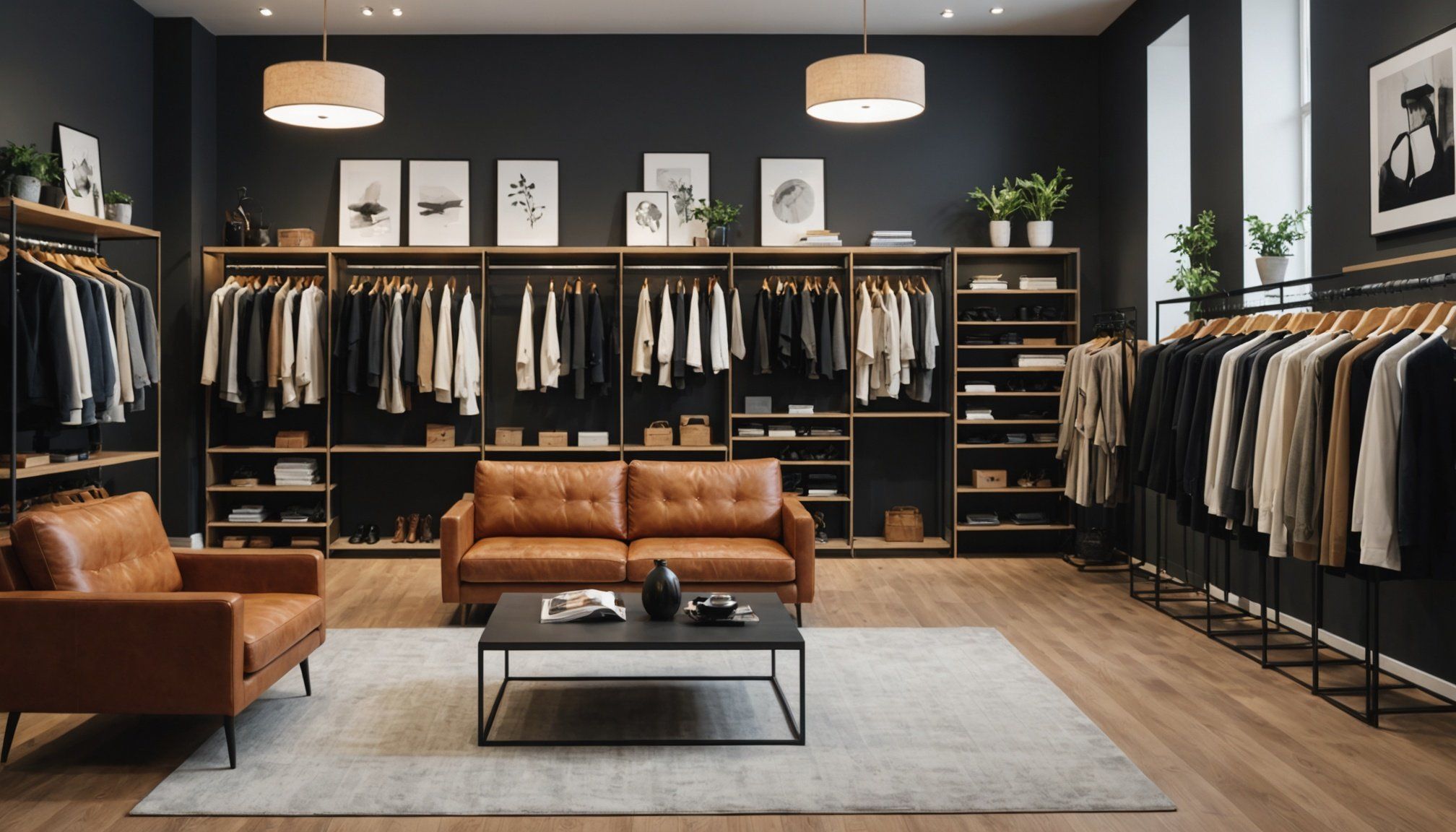Selecting the right furniture for your clothing store goes beyond aesthetics; it’s about creating an inviting atmosphere that enhances customer experience. Consider how each piece can improve product visibility, promote flow, and align with your brand identity. From sustainable materials to versatile designs, choosing practical and stylish options can transform your space, making it both functional and visually appealing. Discover strategies to optimize your store’s layout while staying eco-friendly and budget-conscious.
Understanding the Importance of Furniture Selection for Clothing Stores
Choosing the right furniture for a clothing store goes beyond aesthetics—it’s a strategic decision that significantly influences customer experience and brand perception. Each piece of furniture must contribute to creating a cohesive and welcoming environment that aligns with the store’s identity. It’s crucial to understand how furniture shapes the shopping journey, from enhancing product visibility to optimizing store layout for efficient customer flow.
In parallel : Choosing the best event agency in Paris
Enhancing Customer Experience and Brand Perception
Furniture plays a pivotal role in a store’s overall atmosphere. It reflects the store’s brand and directly impacts how customers perceive your business. For instance, using minimalist and cohesive designs can prevent overwhelming customers, allowing for a more pleasant shopping experience. Unique furniture pieces not only reinforce brand identity but also engage customers visually, making the store memorable. Effective design choices might include feature-rich retail counters or distinctive display stands, which can act as focal points within the store.
Maximizing Product Visibility
Strategic furniture choices can drastically improve product visibility, especially in smaller stores. For example, versatile display tables and double-sided displays enhance viewing opportunities, ensuring that all products are showcased optimally. Effective use of cardboard boiserie can create functional walls fitting for modular displays, beneficial for franchises and stores looking to change up their layout frequently. Employing these display techniques can lead to increased product interaction and a boost in sales.
In the same genre : What Are the Key Steps for Developing a Mobile Learning Platform for a Swindon-Based Business School?
Facilitating Customer Flow and Maximizing Space
Effective store layout design begins with understanding how customers move through your space. Careful placement of display furniture helps guide this flow, ensuring that every customer journey is seamless and fluid. Partition panels can creatively utilize corners for additional features like fitting rooms, ensuring no space is wasted. This thoughtful use of space not only maximizes utility but also enhances the shopping experience by creating a more organized environment. From the entrance to exit, furniture should direct customer movement naturally without causing bottlenecks.
Embracing Sustainable and Functional Choices
Sustainability is becoming increasingly important in retail environments. Choosing eco-friendly furniture options, such as cardboard fixtures that are completely recyclable, aligns your store with sustainable practices valued by today’s consumers. Moreover, the functionality of furniture is equally essential—cash counters with built-in storage or mannequins strategically placed to influence buyer decisions can significantly enhance operational efficiency and customer experience.
Choosing the perfect furniture isn’t just about following trends; it’s about understanding the essence of your brand and how your store’s environment influences customer behavior. By carefully selecting and positioning [www.retif.es] furniture options for boutique environments, stores can craft spaces that are both visually appealing and functionally superior.
Essential Furniture Elements for Clothing Retail
Creating an inviting and functional clothing retail environment relies heavily on the strategic selection and placement of essential furniture pieces. These elements not only enhance the shopping experience but also reflect and reinforce brand identity.
Display Furniture Options
Display furniture is central to showcasing products effectively in a clothing store. By selecting the right types, you optimize product visibility and contribute to a cohesive store atmosphere. Display tables and plinths, for example, are versatile pieces that allow you to highlight feature items and create focal points throughout the store. These can be used to display collections, spotlight new arrivals, or feature seasonal items.
When considering display furniture, think about pieces like double-sided displays which are beneficial in smaller spaces, offering flexible arrangements. Tree-shaped displays, with their symmetrical design, serve both window displays and interior setups well by utilizing limited space while maximizing product exposure. Incorporating wall shelving enhances available vertical space, allowing for expanded product display without cluttering the floor.
Racks for Clothing Display
Essential for any clothing retail environment, racks serve as the backbone for product presentation. They are available in various designs, from simple single rods to more elaborate multi-tiered structures, each offering unique benefits depending on your needs.
In terms of material, consider using wooden racks for a warm and sophisticated look or metal racks for more industrial or modern themes. The use of racks should align with your store’s overall aesthetic while being robust enough to handle varying loads of clothing items.
Integrate modular rack systems to allow easy rearrangement and customization based on seasonal collections or changing brand strategies. This adaptability helps maintain a fresh and dynamic store layout, encouraging repeat visits from customers who are keen to discover new floor layouts and offerings.
Fitting Room Furniture Considerations
No clothing store is complete without well-designed fitting rooms. These spaces are vital to customer satisfaction as they offer a private area to try on garments. Start with comfortable seating, like a small bench or ottoman, that allows customers to easily put on shoes or change. Mirrors should be full-length and well-lit to provide an accurate reflection, enhancing the trial experience.
In terms of privacy, consider using partition panels that can flexibly adapt to the size and layout of your fitting area. This is especially useful in stores with limited square footage, where maximizing space efficiency is key.
Comforting touches such as soft lighting, hooks for hanging extra items, and perhaps a small shelf or table for personal items can create a more inviting atmosphere. Thoughtfully designed fitting rooms not only improve comfort but also potentially increase conversion rates, as customers feel more confident and willing to purchase items they have tried on.
By focusing on these essential furniture elements, you create a store environment that is both beautiful and functional, ultimately enhancing the overall shopping experience for your customers.
Design Considerations for Retail Furniture
Designing a retail space involves careful consideration of many factors, including furniture selection. From functionality and aesthetics to durability and cost, there are numerous elements to weigh when choosing the right pieces. Let’s explore the key design considerations for retail furniture.
Color Schemes for Store Furniture
Establishing the right color scheme is fundamental in creating an inviting and coherent atmosphere in a clothing store. The choice of colors can significantly influence customer emotions and their shopping behavior. In fashion boutiques, soft tones like almond green and powder pink are often preferred for their calming and sophisticated appeal. These hues encourage a relaxed browsing experience and subtly highlight merchandise without overwhelming the senses. For stores with a thematic approach, such as a rock-themed boutique, deeper shades like Noir Charbonneux can echo the brand’s edgy personality.
Consistency in color selection throughout the store also aids in maintaining a seamless visual flow. This uniformity reinforces brand identity and avoids confusing customers with clashing aesthetics. Thoughtful integration of accent colors can accentuate specific areas or highlight new arrivals, subtly guiding the customer journey through the space.
Aesthetic Furniture Designs for Fashion Boutiques
The aesthetic design of furniture in fashion boutiques serves as a silent ambassador for the brand. Elements such as sleek display tables and elegant mannequins create focal points that draw attention to high-value merchandise. Opting for furniture with clean lines and minimalist design can enhance the overall shopping experience by making the store feel spacious and organized.
Incorporating eco-friendly materials like recyclable cardboard furniture not only aligns with sustainable practices but also allows for creative customization. Cardboard boiserie, for example, provides versatile, unique walls that can be adapted for seasonal changes or promotional events. Moreover, using upcycled or vintage pieces can add character and convey a curated, bespoke shopping experience that resonates with eco-conscious consumers looking for authenticity.
Furniture That Enhances Customer Experience
Furniture plays a pivotal role in shaping the customer experience in clothing stores. Ergonomically designed furniture, such as comfortable footwear stools featuring high-density foam, enhances the practical aspects of trying on products. Similarly, strategically placed display plinths and shelves improve product visibility, allowing shoppers to easily explore available items.
The layout and arrangement of display furniture should cater to the flow of customer traffic, guiding visitors seamlessly through the store. Utilizing multifunctional furniture solutions such as clothes racks with shelving helps maximize limited spaces, ensuring every corner is utilized effectively. Meanwhile, integration of elements like mirrors and appropriate lighting around retail counters can elevate the shopping environment, making it more interactive and visually appealing.
Overall, investing in furniture that supports a coherent theme and prioritizes customer comfort can transform a simple store visit into a memorable retail experience. This strategic approach not only supports sales but also strengthens brand loyalty by ensuring customers feel valued and engaged.
Practical Tips for Budget-Friendly Furniture Selection
Looking to furnish your home without breaking the bank? Our practical tips will guide you through the process of finding stylish and functional furniture that fits your budget. Discover how to make smart choices and create a space you’ll love.
Sustainable Furniture Choices for Stores
Embracing sustainable furniture options is not just environmentally responsible but also financially savvy. Cardboard furniture offers a great starting point, being 100% recyclable and surprisingly sturdy for retail environments. These pieces are not only cost-effective but also provide modularity and flexibility, allowing you to easily rearrange your store layout or update its aesthetics. Opt for minimalist designs, which are inherently energy-efficient during production and often align with contemporary retail trends.
When selecting sustainable materials, consider bamboo. This rapidly renewable resource is both durable and stylish, allowing for the crafting of sleek and ergonomic fixtures that enhance the shopping experience. Furthermore, reclaimed wood presents an opportunity to add character and unique charm to your store, often at a lower price point than newly manufactured products.
Locally Sourced Furniture Options
Choosing locally sourced furniture is another effective strategy for maintaining budget-friendly operations in a retail store. Besides supporting your local economy, purchasing from nearby suppliers often reduces shipping costs, which can be significant for oversized items like shelves and counters. Additionally, local artisans can provide bespoke furniture solutions, such as custom-made shelving units or distinctive display cases, tailored to fit your shop’s specific needs and branding.
By sourcing locally, you gain the opportunity to collaborate closely with the producers, ensuring that the pieces not only match your aesthetic vision but also meet the functional requirements essential for efficient retail operations. For example, you might opt for fitted pieces that maximize floor space and incorporate eco-friendly paint and finishes, aligning with a sustainable business model.
Tips for Customizing Store Furniture for Unique Branding
Personalizing your store’s furniture is crucial in establishing a strong brand identity. A well-designed cash counter acts as a focal point, reflecting the store’s aesthetic while serving practical functions such as secure storage and organized transaction spaces. Consider integrating technology in these designs, utilizing tablets for checkout to streamline processes and accommodate modern shopping preferences.
Another customization option lies in modular furniture systems, which offer versatility in arrangement. This adaptability enables you to rearrange layouts for seasonal promotions or to highlight new product lines, maintaining a dynamic and inviting atmosphere. Additionally, adapting color schemes and materials to echo your store’s narrative helps in creating a unified look throughout your retail space. For example, a children’s boutique may benefit from bright, cheerful hues and softer textiles, while a high-end fashion store could amplify luxury through dark woods and muted metallic accents.
For a distinctive touch, engage customers with interactive furniture pieces, such as seating areas with integrated USB ports or product displays that encourage tactile exploration. This not only enhances the customer experience but also reinforces the brand identity through innovative design elements.
Selecting the right furniture for your clothing store doesn’t have to strain your budget. By focusing on sustainable materials, locally sourced options, and personalized designs, you can create a visually appealing and functional retail environment that resonates with your brand ethos and enhances the overall customer experience.











